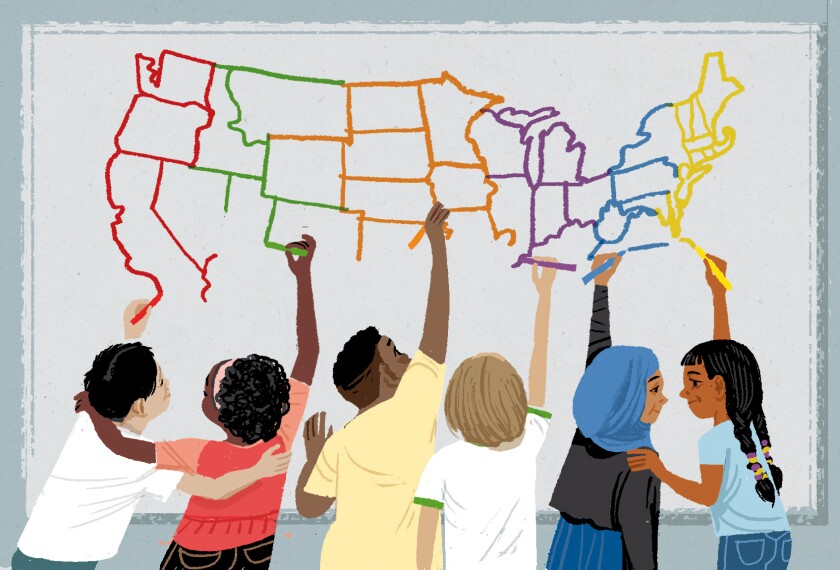This story is part of a special project called Big Ideas in which EdWeek reporters ask hard questions about K-12 education’s biggest challenges and offer insights based on their extensive coverage and expertise.
I was a local reporter in Bangor, Maine, in December 2019 when I heard three Black students first voice their complaints at a joint school committee and city council meeting about years of racism they endured at one of the state’s largest high schools. Black students, who make up less than 4 percent of the school’s population, said their white classmates justified white supremacy during classroom discussions, defended the enslavement of Black people, told them to “go back where they came from,” and regularly said the “N” word in the schools’ hallways and classrooms, according to six months of reporting I conducted in 2020.
For years, Bangor’s school officials ignored the litany of complaints students filed, but when my article, “,” was published last May, amid nationwide protests spurred by the murder of George Floyd, the response from the school department was swift and abrupt.
The district hired a Black-led equity and justice institute to offer diversity training for teachers, commissioned an independent investigation of the students’ claims that cost the district at least $70,000, and overhauled the high school’s history and English curriculum to include more voices of color. And it set up a way for middle and high school students to report discrimination using their school-issued devices. Claims now go directly to the newly hired affirmative action coordinator.
But was it enough to change the high school experience of students of color in Bangor?
Initially, I thought it must be. The administrators seemed committed to equity in school, and the district appeared to be investing lots of money and time into these initiatives. But I’ve been watching and reporting what’s been happening in the country in the year following Floyd’s murder. I’ve also thought back to my own high school experience in India where I was part of the dominant caste. And I’m no longer so convinced.
Across the nation, America’s school districts are rapidly diversifying. This has accelerated in recent years K-12 leaders’ historically fitful efforts to make classrooms and schools equitable for students of color.
Racism inside America’s classrooms received outsized attention during the pandemic as disparities widened, student activism revved up, and the parents of students of color peeked over their children’s shoulders during remote schooling, many witnessing teachers’ biases and microaggressions up close.
After last spring and summer’s Black Lives Matter protests, superintendents across the country pledged in seemingly heartfelt letters to parents that they’d do everything in their power to fight racism in their schools. Several dozen districts abolished their school police force. A handful of others overhauled the way they screen children for their gifted programs. Still others set up affinity groups for their students of color.
But when a recently conducted EdWeek Research Center survey asked principals and district leaders what, if any, anti-racism efforts their district or school took on following the calls for racial justice last year, the most common response—with 34 percent of respondents—was diversity or anti-bias training, which research suggests isn’t promising for long-term change. Almost as many—33 percent—said their districts or schools made no changes.
In Bangor, efforts have gone above and beyond just diversity training. This April, the school committee hired Superintendent James Tager, who said the district would continue working on diversity, equity, and inclusion. Later this year, the district plans to conduct an “equity audit,” starting with the high school, to assess culture and opportunity gaps.
But experts warn that might not be enough to create lasting change, especially since those efforts were driven by public—not district-level— pressure.
“My hunch is that a lot of districts, when the pressure is taken off, ultimately resort back to who they were in the first place and go back to some same practices they had beforehand. That’s why you have to put mechanisms in place via committees or policies to ensure that the work does not stop,” said Tyrone Howard, a professor of education at University of California, Los Angeles, and associate dean for equity and inclusion for the Graduate School of Education and Information Studies.
“One way to do that is to make sure you commit ongoing resources to the efforts that are dedicated to these kinds of initiatives.”
Even as districts try to sustain their anti-racism initiatives, they face a new nationwide, legislative threat aiming to erase that work.
Even as districts try to sustain their anti-racism initiatives, however, they face a new nationwide, legislative threat aiming to erase that work.
When I was hired by Education Week this spring as one of two new Race & Opportunity reporters, I expected that my reporting and writing efforts would focus mostly on how all these post-George Floyd efforts would shake out.
But after the contested defeat of President Donald Trump in November, the backlash to Black Lives Matter began. Republican state legislators across the country began outlawing districts’ anti-racism efforts, and I quickly pivoted to untangling a convoluted debate over systemic racism and how teachers talk to students about America’s racist past.
Today, 12 states have restricted classroom conversations about racism and sexism, which puts anti-racism initiatives, including anti-bias training and culturally responsive teaching at risk. Some have even banned The New York Times’ 1619 Project, a series of essays published on the 400th anniversary of the beginning of American slavery that put the legacy of slavery and the contributions of Black Americans at its center. Republican lawmakers claim these efforts make white students feel uncomfortable and are demoralizing and anti-American.
But while the country is wrapped up in debating critical race theory, an academic framework that explains the systemic nature of racism, students of color continue to face discrimination in schools across the nation, just as the Bangor students had. Racism against students of color in America’s public school system is real, and the resulting lag in test scores for a growing chunk of the student body reflects this fact. Denying this reality won’t make it go away.
Coming from India, I learned that people can’t be passive about discrimination. But it took my move to America and my reporting in Bangor and at Education Week to see this fully. Here, in America, I’m a brown woman and an immigrant, but in my private high school in India, I was part of the privileged group. Indian casteism and colorism were as present in my high school as racism is here. No curriculum change or affirmative action coordinator could have prevented all of the discrimination students faced. That would have required all of us in the dominant caste to get on the same page about the origins and history of the caste system, how it’s present in the modern day, and why it’s morally wrong. And because our teachers and administrators and our families could not identify the ways in which the school system was inherently casteist—we perpetuated it. Collectively.
You probably won’t be surprised to learn that Bangor’s efforts continue to meet roadblocks. Even after the district offered diversity training to students and staff, overhauled its history and English curriculum, and hired an affirmative action officer among other inclusion efforts, the Black students—two of the five I had originally interviewed—said the anti-racism initiatives were a mixed success.
Angela Okafor, the city’s first and only Black city councilor, put it this way: “I would not necessarily say that things have changed, neither can I say that things have remained the same.”
If there’s one thing I can say with confidence after talking to Bangor’s high schoolers for six months, it’s that they are willing to step up. And that’s good news. If schools keep doing the best they can to help everyone, and, particularly, if white students and teachers understand the history of how and why people of color were treated as they were in the past and why that needs to change with the investment of a lot of time, money, and commitment, the experiences of students of color in school may improve.
But I remain skeptical. I don’t know that schools can fundamentally change the mindset of teachers, administrators, parents, and students, perhaps because I come from a culture where racism, too, is so deeply embedded. The answer might be that it can’t. Because unless you acknowledge that systemic racism is ingrained in schools, pledge to identify how, and work constantly to make changes, the education system will not get better. I stand on more than 3,500 years of Indian history to prove it.





